BM-21 "Grad": the heir of two opponents
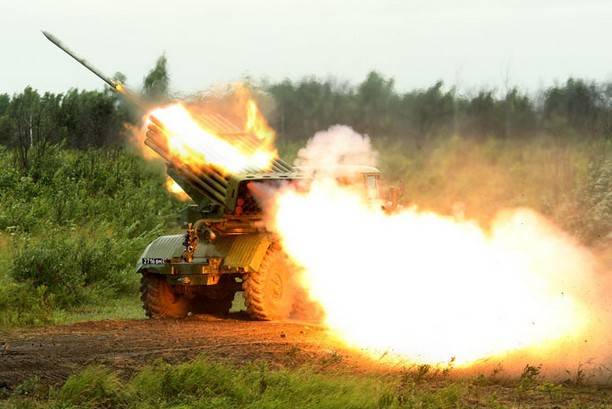
The fire is led by the BM-21 “Grad” division field reactive system of volley fire. Photos from http://kollektsiya.ru
Soviet and then Russian multiple launch rocket systems (MLRS) became the same world-famous symbol of the Russian armory schools, like their predecessors - the legendary Katyusha and Andryusha, they are also BM-13 and BM-30. But unlike the same Katyusha, story the creation of which is well researched and studied, and also was actively used for propaganda purposes, the beginning of work on the creation of the first mass post-war MLRS - BM-21 “Grad” - was often passed over in silence.
Whether secrecy was the reason or unwillingness to mention where the most famous post-war reactive system of the Soviet Union originates from is difficult to say. However, for a long time, this did not arouse keen interest, since it was much more interesting to observe the actions and development of domestic MLRS, the first of which was adopted by 28 March 1963. And soon after that, publicly declared itself when, with its volleys, it actually multiplied by zero the units of the Chinese army that had been established on Damanski Island.
Meanwhile, “Grad”, admittedly, “speaks” with a German accent. And what is especially curious, even the name of this rocket launcher system directly echoes the name of the German rocket system, which was developed during the Second World War, but did not have time to seriously participate in it. But it helped the Soviet gunsmiths, who took it as a basis, to create a unique combat system, which for more than four decades has not been descending from the theaters of hostilities around the world.
"Typhoons" threaten "Libretors"
“Typhoon” - that’s the name of the family of unguided anti-aircraft missiles, the development of which German engineers from the Peenemuende missile center, famous for creating the world's first V-2 ballistic missile, began in the middle of World War II. The exact date of commencement of work is unknown, but it is known when the first prototypes of Typhoons were submitted to the Ministry aviation The Third Reich - at the end of 1944.
Most likely, the development of anti-aircraft unguided missiles in Peenemuende did not take place until the second half of the 1943 year, after the leadership of Nazi Germany - both political and military - became aware of the avalanche-like increase in the number of medium and heavy bombers among the countries participating in the anti-Hitler coalition. But most often, the researchers cite the beginning of the 1944 of the year as a real start date for work on anti-aircraft missiles - and this seems to be true. Indeed, taking into account the existing developments in missile weapons, the Peneemuende missile designers did not need more than six months to create a new type of missile weapon.
Uncontrolled Typhoon anti-aircraft missiles were 100-millimeter rockets with a liquid (Typhoon-F) or solid-fuel (Typhoon-R) engine, an 700-gram warhead and stabilizers installed in the tail section. They, according to the developers, should have stabilized the rocket on the course in order to ensure the range and accuracy of the hit. Moreover, the stabilizers had a slight slope in 1 degrees relative to the horizontal plane of the nozzle, which gave the rocket rotation in flight - by analogy with a bullet fired from a rifle weapon. By the way, there were also screw guides from which the rockets were launched - with the same purpose to give them rotation, ensuring range and accuracy. As a result, "Typhoon" reached a height of 13-15 kilometers and could become a formidable anti-aircraft weapon.
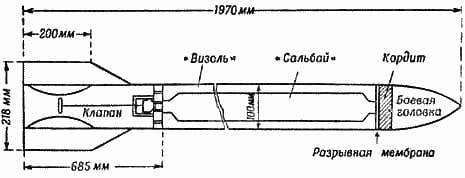
Scheme of an unmanaged anti-aircraft missile "Typhoon". Photos from http://www.astronaut.ru
The “F” and “P” variants differed not only in engines, but also externally in terms of dimensions, weight, and even the range of stabilizers. For liquid “F” it was 218 mm, for solid “P” - two millimeters more, 220. The length of the missiles was different, although not too much: the 2 meter in P and 1,9 in F. But the weight differed dramatically: “F” weighed a little more than 20 kg, whereas “P” - almost 25!
While the engineers at Peenemünde invented the Typhoon missile, their colleagues from the Skoda plant in Pilsen (now Czech Pilsen) were developing a launcher. As a chassis for it, they chose a carriage from Germany’s most massive anti-aircraft gun, the 88-millimeter, whose production was well developed and conducted massively. The 24 (on the prototype) or 30 (on the adopted) guides were installed on it, and this “package” received the possibility of circular firing at high elevation angles: just what was required for salvo firing of unguided anti-aircraft missiles.
Since, in spite of the novelty of the equipment, every Typhoon rocket, even more labor-intensive “F”, did not exceed the 25 marks in serial production, the order was immediately placed on 1000 type “P” and 5000 type “F” missiles. The next one was already much bigger - 50 000, and by May 1945, it was planned to launch a million 1,5 million rockets of this model every month! That, in principle, was not so much when you consider that each Typhoon missile battery consisted of 12 launchers on 30 guides, that is, its total salvo was 360 missiles. Such a battery, according to the Ministry of Aviation, by September 1945 had to be organized as much as 400 - and then for one volley they would launch thousands of missiles at British and American bomber on 144. So, a month and a half million would just be enough for ten such volleys ...
"Swift", taking off from "Typhoon"
But neither by May nor all the more by September 1945 did any 400 batteries and 144 thousands of missiles have been worked out in one gulp. The total release of "Typhoon", according to military historians, amounted to only 600 pieces that went to the test. In any case, there is no exact information about their combat use, and the Allied Air Command would not miss a chance to take note of the use of a new anti-aircraft weapon. However, even without this, Soviet military experts and their allied colleagues immediately appreciated what an interesting piece of weapons they had in their hands. The exact number of Typhoon missiles of both types, which were at the disposal of the engineers of the Red Army, is unknown, but it can be assumed that these were not isolated instances.
The further fate of rocket trophies and developments based on them was determined by the famous decree No. 1017-419 of the Council of Ministers of the USSR "Issues of jet weapons" dated 13 May 1946. Work on the "Typhoon" divided on the basis of the difference in the engines. Liquidity Typhoons F were taken up at Sergei Korolev Special Design Bureau at the Research Institute-88 - so to speak, under jurisdiction, because the work on all other liquid-propellant rockets, primarily on the V-2, was also transferred there. A solid "Typhoon R" had to do created by the same decree of KB-2, which was included in the structure of the Ministry of Agricultural Engineering (here it is, all-pervasive secrecy!). It was to this design bureau that the domestic version of Typhoon R, the Strike missile, which was the prototype of a missile for the future Grad, was to be created.
The Strizh direction in KB-2, which from 1951 of the year combined with Plant No. 67 - the former Heavy and Siege Artillery Workshops - became known as the State Specialized Research Institute-642, was a future academic, twice Hero of Socialist Labor, creator of the famous missile systems "Pioneer" and "Topol" Alexander Nadiradze. Under his leadership, the developers of Stryzh brought the work on this rocket to tests that were carried out at the Donguz testing ground - at that time the only training ground on which all types of air defense systems were worked out. For these tests, the former "Typhoon R", and now the "Swift" P-115 - the main element of the reactive anti-aircraft system RZS-115 "Crow" - was released in November 1955, with new characteristics. Its weight now reached almost 54 kg, the length grew to 2,9 meter, and the weight of the explosive in the warhead to 1,6 kg. Increased and the range of shooting horizontally - to 22,7 km, and the height of the shooting - the maximum is now 16,5 km.
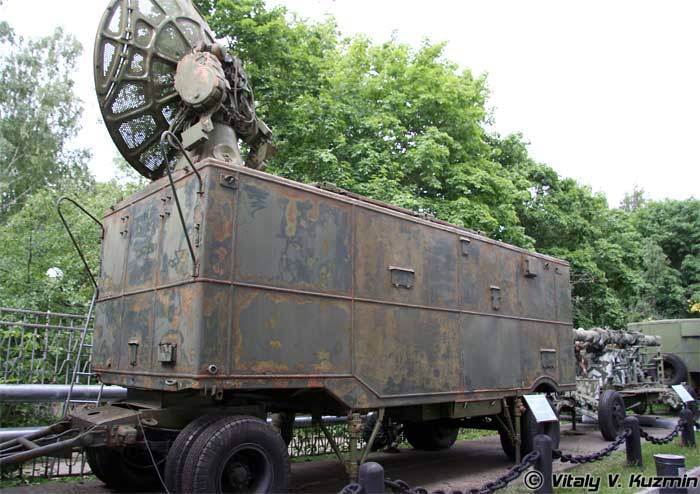
Radar station SOZ-30, included in the system RZS-115 "Raven". Photos from http://militaryrussia.ru
According to the technical specification, the battery of the system "Raven", consisting of 12 launchers, was supposed to produce 5 missiles in 7-1440 seconds. This result was achieved through the use of a new launcher, designed in the Central Research Institute-58 under the guidance of the legendary artillery designer Vasily Grabin. It was towed and carried 120 (!) Tubular guides on itself, and this package had the possibility of a round-up attack the maximum angle of elevation 88 degrees. Since the missiles were uncontrollable, they were fired in the same way as anti-aircraft guns: they were aimed at the target at the direction of the firing station with a radar station.
It is these characteristics that were shown by the RZS-115 “Raven” system at complex field tests, which took place from December 1956 to June 1957. But neither the high power of the volley, nor the solid weight of the Strizh war unit did not compensate for its main drawback - the low altitude and uncontrollability. As noted by representatives of the Air Defense Command in their conclusion, “due to the low reach of the Strizh shells in height and range (altitude 13,8 km at 5 km distance), limited system capabilities when firing at low-flying targets (less than at an angle 30 °), and insufficient gain in the effectiveness of firing the complex as compared with one to three 130- and 100-mm anti-aircraft guns with a significantly higher projectile consumption; the rocket anti-aircraft system RZS-115 cannot qualitatively improve the armament of anti-aircraft artillery the country's air defense forces. To arm the Soviet army to equip parts of the anti-aircraft artillery troops of the country's air defense system, the RZS-115 system cannot be adopted. ”
Indeed, the rocket, which in the middle of the 1940's would easily have coped with the “Flying Fortresses” and the “Liberators”, ten years later could not do anything with the new B-52 strategic bombers and ever faster and more maneuverable jet fighters. And that is why it remained only an experimental system - but its main component turned into a projectile for the first Russian M-21 “Grad” multiple launch rocket system.
From anti-aircraft to ground
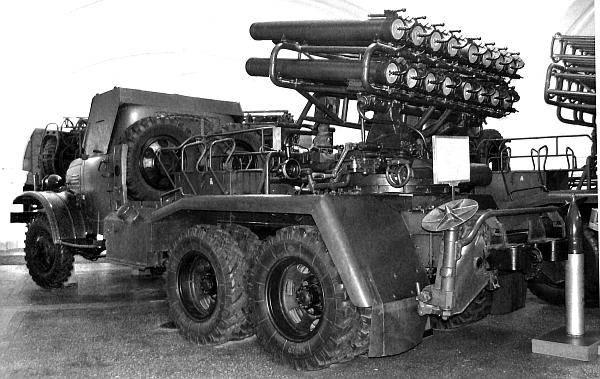
The reactive combat vehicle BM-14-16 is one of the systems to be replaced by the future Grad. Photos from http://kollektsiya.ru
What is remarkable: the resolution of the USSR Council of Ministers No. 17, in which the Scientific Research Institute-642 was instructed to prepare a project for the development of an army high-explosive fragmentation projectile based on P-115, turned out January 3 1956. At this time, the ground tests of two Stryzh missile launchers and 2500 missiles were just deployed, and there was no talk of testing the entire Raven complex. However, in the military environment there was a fairly experienced and intelligent man who appreciated the possibility of using a multi-launch launcher with missiles not against airplanes, but against ground targets. It is very likely that this idea was prompted by the spectacle of the Swifts, launched from one hundred and twenty barrels — it most likely looked very much like a Katyushi volley.
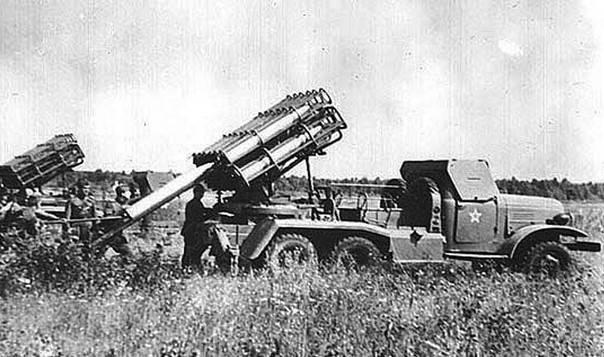
Reactive system BM-24 on exercises. Photos from http://kollektsiya.ru
But this was only one of the reasons why it was decided to convert unguided anti-aircraft missiles into similar unguided missiles to destroy ground targets. Another reason was the obviously insufficient salvo power and the firing range of the systems in service with the Soviet Army. Lighter and, accordingly, more multi-barreled BM-14 and BM-24 could launch 16 and 12 missiles at a time, respectively, but at a distance not more than 10 kilometers. A more powerful BMD-20 with its 200-millimeter feathered projectiles fired almost 20 kilometers, but could launch just four missiles in one volley. And the new tactical calculations clearly demanded a multiple launch rocket system, for which 20 kilometers would be not just the maximum, but the most effective, and with which the total power of the volley would increase in comparison with the existing ones at least twice.
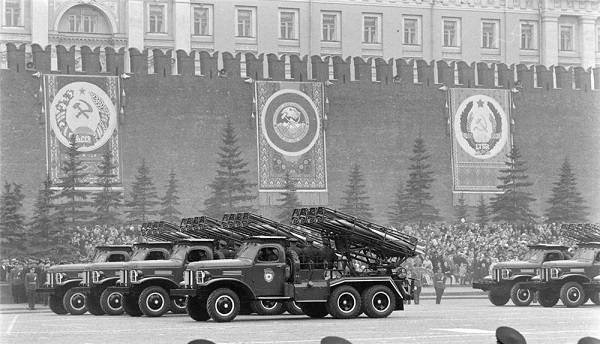
BMD-20 fighting vehicles at the November parade in Moscow. Photos from http://www.rusmed-forever.ru
Based on these introductory, it was possible to assume that for the Swift missile the stated range is quite achievable now - but the weight of the explosive of the warhead is clearly insufficient. At the same time, the excess range allowed us to increase the power of the warhead, due to which the range had to fall, but not too much. That is what was to be calculated and tested in practice by the designers and engineers of GSNII-642. But for this work they were given very little time. In 1957, a leapfrog began with transformations and revisions of the institute's activities: it was first combined with Vladimir Chelomey OKB-52, calling the new research institute-642 structure, and a year later, in the Institute, the former GSNII-1958 turned into a branch Cheleevsky OKB, after which Alexander Nadiradze went to work at the Scientific Research Institute-642 of the Ministry of Defense Industry (the current Moscow Institute of Thermal Engineering, named after him) and concentrated on creating solid-state ballistic missiles.
From the very beginning, the subject matter of the military high-explosive fragmentation projectile did not fit into the direction of the work of the newly formed SRI-642, and in the end it was transferred for revision to the Tula SRI-147. On the one hand, it was absolutely not his problem: the Tula Institute, created in July 1945, was engaged in research work in the field of the production of artillery shells, developing new materials for them and new manufacturing methods. On the other hand, for the “artillery” institute it was a serious chance to preserve and acquire a different weight: Nikita Khrushchev, who replaced Joseph Stalin as head of the Soviet Union, was a categorical supporter of the development of rocket weapons to the detriment of everything else, primarily artillery and aviation. And the chief designer of the NII-147, Alexander Ganichev, did not balk, receiving an order to take on a completely new business for him. And I didn’t lose it: in a few years the Tula Scientific Research Institute became the world's largest developer of multiple launch rocket systems.
"Grad" spreads its wings
But before this happened, the institute’s team had to make tremendous efforts, learning a completely new field for them - rocket science. Least of all problems were with the manufacture of shells for future missiles. This technology was not too different from the technology of manufacturing artillery shells, except that the length is different. And the NII-147 asset was the development of a deep-drawing method that could be adapted for the production of thicker and more durable shells, which are the combustion chambers of jet engines.
It was harder with the choice of engine system for a missile and its very layout. After a lot of research, only four options remained: two - with starting powder engines and sustainer solid-fuel engines of different designs, and two more - with two-chamber solid-fuel engines without starting powder, with rigidly fixed and with folding stabilizers.
In the end, the choice was stopped on a jet with a two-chamber solid-fuel engine and folding stabilizers. The choice of power plant was clear: the presence of a starting powder engine complicated the system, which was supposed to be simple and cheap to manufacture. And the choice in favor of folding stabilizers was explained by the fact that non-folding stabilizers did not allow installing more 12-16 guides on one launcher. This was determined by the size requirements of the launcher for transporting it by rail. But the problem was that the same number of guides was in BM-14 and BM-24, and the creation of the new MLRS provided for an increase in the number of missiles in one salvo.
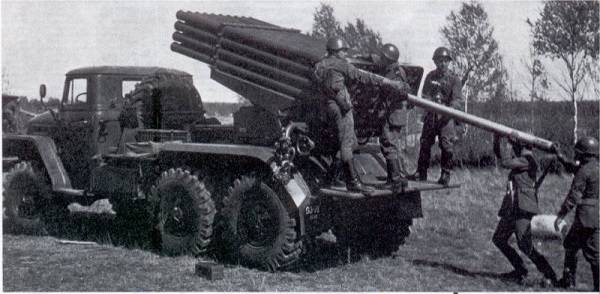
MLRS BM-21 "Grad" at the exercises in the Soviet Army. Photos from the site http://army.lv
As a result, it was decided to abandon the rigid stabilizers - despite the fact that at that time the point of view was dominant, according to which the drop-down stabilizers should inevitably be less effective because of the gaps between them and the rocket body, which arise during the installation of hinges. In order to convince their opponents of the opposite, the developers had to carry out full-scale tests: at the Nizhny Tagil “Staratel” test site from a converted machine from the M-14 system, they conducted control firing with two variants of missiles - with rigidly installed and folding stabilizers. The firing results did not reveal the advantages of one type or another in terms of accuracy and range, which means that the choice was determined only by the possibility of mounting a larger number of guides on the launcher.
So rocket projectiles for the future rocket launcher Grad received - for the first time in Russian history! - opened at the start of the plumage, consisting of four curved blades. When loading, they were kept in the folded state by a special ring, worn on the lower part of the tail section. The projectile flew out of the launch tube, having received the initial rotation due to the screw groove inside the guide, through which the pin in the tail section slid. And as soon as he was free, stabilizers were opened, which, like the "Typhoon", had a deviation from the longitudinal axis of the projectile by one degree. Due to this, the projectile received a relatively slow rotational motion - on the order of 140-150 revolutions per minute, which ensured its stabilization on the trajectory and accuracy of impact.
What got Tula
It is noteworthy that in recent years, in the historical literature devoted to the creation of the Grad MLRS, it is often said that the NII-147 received into the hands of a practically finished missile, which was the Strizh P-115. Say, the institute’s merit in bringing someone else’s development to mass production was small: it’s just that a new method of hot-drawing of the body was invented - and that’s all!
Meanwhile, there is every reason to believe that the design efforts of NII-147 specialists were much more substantial. Apparently, they received from their predecessors - Alexander Nadiradze's subordinates from the GSNII-642 - only their groundwork for the possibility of adapting an unguided anti-aircraft missile to use for ground targets. Otherwise it is difficult to explain why 18 April 1959, the deputy director of the Scientific Research Institute-147 for the scientific part, and he was the chief designer of the institute Alexander Ganichev sent a letter that received outgoing No. 01844 to the head of the 1 department of the Artillery Scientific and Technical Committee of the Main Artillery Directorate GAU) of Major General Mikhail Sokolov with a request to give permission to acquaint representatives of the Scientific Research Institute-147 with the data of the Strizh projectile in connection with the development of the projectile to the Grad system.
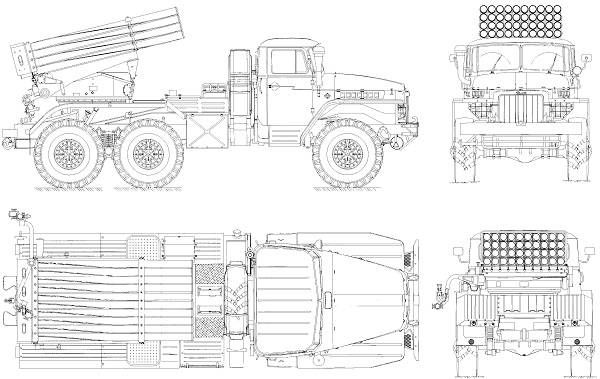
The general scheme of the BM-21 combat vehicle, ascending into the Grad rocket launcher system. Photos from http://www.russianarms.ru
And only this letter would be welcome! No, there is also an answer to it, which was prepared and sent to the Director of the Scientific Research Institute-147, Leonid Khristoforov, Deputy Head of the 1 General Directorate of the ASTC, Colonel Pinchuk. It states that the Artillery Scientific and Technical Committee sends to Tula a report on the testing of the P-115 projectile and drawings on the engine body of this projectile - so that these materials can be used in the development of a rocket to the future Grad system. What is curious is that the report and the drawings were given to the people of Tula for the time being: they were to be returned to the 1 to the Directorate of the ASTC GAU before 15 August 1959.
Apparently, this correspondence was just about finding a solution to the problem of which engine is best to use on a new missile. So to claim that "Swift", as well as its progenitor "Typhoon R", are an exact replica of the projectile for the future "Grad" - at least unfair to the Tula research institute-147. Although, as can be seen from the entire history of the development of the BM-21, traces of the German rocket genius are undoubtedly present.
By the way, it is very noteworthy that the Tula did not appeal to anyone, but to Major General Mikhail Sokolov. This man, in May 1941, graduated from the Artillery Academy. Dzerzhinsky participated in the preparations for the demonstration to the leadership of the USSR of the first copies of the legendary "Katyusha": as you know, it was held in Sofrino outside Moscow on 17 in June of the same year. In addition, he was one of those who trained the crews of these combat vehicles and, together with the first commander of the Katyush battery, captain Ivan Flerov, trained the fighters to handle the new technology. So, multiple rocket launcher systems were not just a well-known subject for him — one might say he devoted almost all his military life to them.
There is another version of how and why the Tula Scientific Research Institute-147 received the 24 February 1959 of the year the order of the USSR Council of Ministers Committee on Defense Technology to develop divisional multiple rocket launchers. According to her, the Sverdlovsk SKB-203, formed in 1949 year specifically for the development and pilot production of ground-based rocket technology, was supposed to deal with the initial creation of a modified system using the Strigzh rocket. Say, when SKB-203 realized that they could not fulfill the requirement to place 30 guides on the unit, because the inconsistent rocket stabilizers interfered, they came up with an idea with folding plumage, which is retained by the ring when loading. But since they couldn’t actually bring this modernization of the rocket to serial production at SKB-203, they had to look for an executor, and by a happy random, the chief designer of the bureau, Alexander Yaskin, met Tulak Alexander Ganichev, who agreed to take on this work.
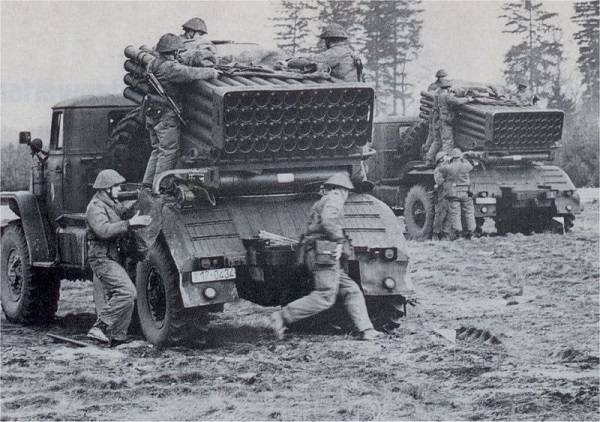
BM-21 on the teachings of the National People's Army of the GDR - one of the countries of the Warsaw Pact, where the "Grad" was in service. Photos from the site http://army.lv
This version, which does not have any documentary evidence, looks, to put it mildly, strange, and therefore we leave it on the conscience of its developers. We only note that in terms of development work on the 1959 year, approved by the USSR Minister of Defense and agreed with the State Committee of the USSR Council of Ministers on defense technology, the Moscow Scientific Research Institute-24 - the future Scientific-Research Machine-Building Institute named Bakhireva, at that time the former main developer of ammunition. And it is most logical that the development of a missile at the Scientific Research Institute-24 was decided to be put on the shoulders of colleagues from the Tula Scientific Research Institute-147, and the development of the launcher should be left behind the Sverdlovsk SKB-203, and even recently, organized.
Damansky Island - and onward everywhere
12 in March 1959 approved Tactical and Technical Requirements for developmental work No. 007738 “Grad” divisional field rocket system, in which once again the developer roles were assigned: NII-24 - the main developer, NII-147 - the developer of the rocket engine , SKB-203 - launcher developer. 30 of May 1960 of the Year saw the light of the resolution of the Council of Ministers of the USSR No. 578-236, which set the beginning of work on the creation of the already not experienced, but the serial Grad system. This document assigned to the SKB-203 the creation of combat and transport vehicles for the Gradot MLRS, the scientific research institute-6 (today the Central Research Institute of Chemistry and Mechanics) - the development of new types of gunpowder RSI for solid-fuel engine charge, GSKB-47 - The future of Basalt, an NPO, is the creation of a warhead for rockets, and the development of mechanical fuses at the Balashikha Research Institute of Technology. And then the Main Artillery Directorate of the Ministry of Defense issued tactical and technical requirements for the creation of the “Grad” Field Rocket System, which was no longer viewed as an experimental design topic, but as the creation of a serial armament system.
After the release of the government decree, a year and a half passed before the first two combat vehicles of the new Gradz MLRS, created on the basis of the Ural-375D, were presented to the military from the Main Rocket and Artillery Directorate of the USSR Ministry of Defense. Three months later, 1 March 1962, at the artillery range "Rzhevka" near Leningrad began ground tests "Grada". A year later, 28 March 1963, the development of the BM-21 ended with the adoption of a resolution of the Council of Ministers of the USSR on the launch of a new rocket launcher system “Grad” into service.
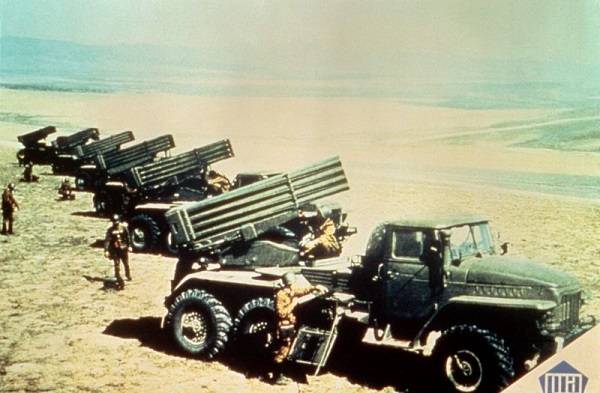
“Grads” of early releases at divisional exercises in the Soviet Army. Photos from the site http://army.lv
After another ten months, 29 January 1964, a new decree appeared - on the launch of "Gradov" in mass production. And on November 7, 1964, the first serial BM-21 took part in the traditional parade on the occasion of the anniversary of the October Revolution. Looking at these formidable installations, each of which could have fired four dozen rockets, neither Muscovites, nor foreign diplomats and journalists, nor even many military participants of the parade knew that in reality none of them were capable of full-fledged combat work. for the fact that the factory did not have time to get and install electric artillery units.
Five years later, on March 15, 1969, the Grads received their baptism of fire. This happened during the battles for Damansky Island on the Ussuri River, where Soviet border guards and the military had to repel the attacks of the Chinese army. After neither infantry attack nor tanks the Chinese soldiers could not be forced out of the captured island, it was decided to use a new artillery system. The 13th Separate Jet Artillery Division, under the command of Major Mikhail Vashchenko, was part of the artillery of the 135th Motorized Rifle Division, which took part in repelling Chinese aggression. As expected in the state of peacetime, the division had BM-21 Grad combat vehicles in its arsenal (in military time states, their number increased to 18 vehicles). After the Grads fired a salvo at Damansky, the Chinese lost within ten minutes, according to various sources, up to 1000 people only killed - and the PLA units fled.
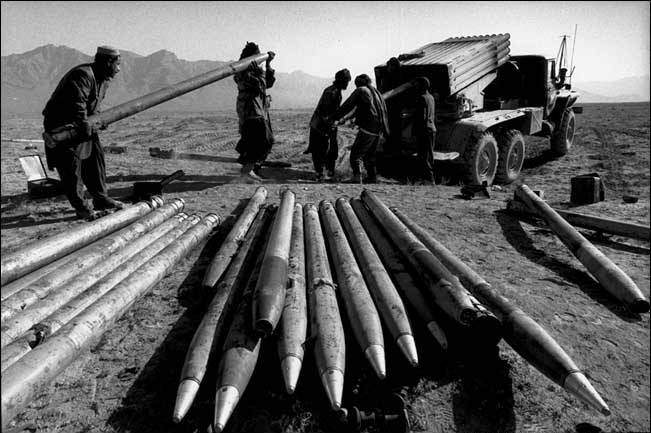
Missiles to the BM-21 and the launcher itself, fell into the hands of the Afghan Taliban after the withdrawal of Soviet troops from the country. Photos from the site http://army.lv
After that, “Grad” fought almost continuously, although mostly outside the territory of the Soviet Union and Russia. The most widespread use of these reactive systems must apparently be considered their participation in the hostilities in Afghanistan as part of the limited contingent of Soviet troops. On their land, BM-21 were forced to shoot during both Chechen campaigns, and on a foreign one, perhaps in half the states of the world. After all, in addition to the Soviet Army, the armies of the army were still fifty states, not counting those that were in the hands of illegal armed groups.
Today, the BM-21 Grad, which has won the title of the most massive multiple launch rocket system in the world, is being phased out of the Russian army and fleet: as of 2016, only 530 of these combat vehicles are in service (about 2000 more are in storage). He was replaced by new MLRS - BM-27 "Hurricane", BM-30 "Smerch" and 9K51M "Tornado". But it’s too early to write off the Grads completely - just as it was once too early to refuse multiple launch rocket systems, as they did in the West and did not want to go to the USSR. And did not fail.
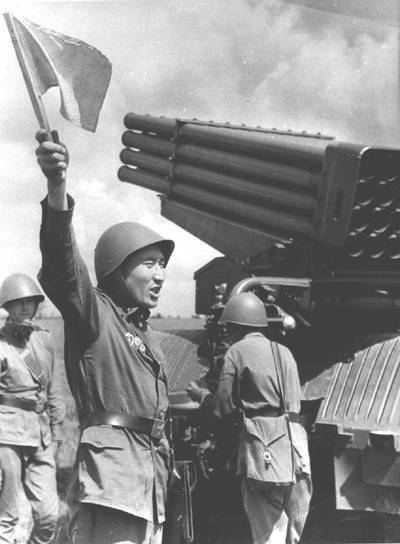
Adopted by the Soviet Army MLRS BM-21 "Grad" is still in service with the Russian Army. Photos from the site http://army.lv
Information